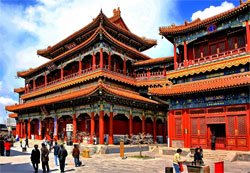
What is the history of Lama Temple Beijing?
Nestled amidst the bustling cityscape of Beijing, the Lama Temple stands as a serene sanctuary and a testament to the rich history of Tibetan Buddhism in China. Its origins can be traced back to the Qing dynasty, where it has undergone a captivating transformation over the centuries.
Early Beginnings: From Imperial Residence to Monastery
Construction of the Lama Temple commenced in 1694 during the reign of the Kangxi Emperor. Initially, the site served as the official residence for court eunuchs. However, in 1722, following the ascension of Prince Yongzhen to the throne as the Yongzheng Emperor, the complex was divided.
Half of the complex remained an imperial residence, while the other half was converted into a lamasery—a monastery for Tibetan Buddhist monks. This decision marked the beginning of the Lama Temple’s journey as a significant center for Tibetan Buddhism in China.
Transformation into a Tibetan Buddhist Monastery
In 1744, under the reign of the Qianlong Emperor, the Lama Temple underwent a pivotal transformation. It was officially designated as a Gelugpa monastery, the same school of Tibetan Buddhism to which the Dalai Lama belongs. This designation elevated the Lama Temple’s status, attracting monks and scholars from Tibet and other parts of China.
The Lama Temple's Role in Tibetan Buddhist History
Over the following centuries, the Lama Temple flourished as a vibrant center for religious practice, scholarship, and cultural exchange. It housed a large community of monks and played a crucial role in the dissemination of Tibetan Buddhist teachings throughout China.
The temple's exquisite architecture, adorned with intricate carvings, colorful murals, and towering statues, served as a powerful expression of Tibetan Buddhist art and aesthetics. Its halls became spaces for prayer, meditation, and philosophical discourse.
The Lama Temple Today: A Spiritual Haven and Cultural Treasure
Today, the Lama Temple stands as the most renowned Tibetan Buddhist monastery in Beijing. It continues to serve as a spiritual refuge for a dedicated community of monks, with a particular focus on Mongolian Buddhism. Visitors can witness monks engaging in chanting rituals, offering incense, and prostrating before sacred statues.
Visiting the Lama Temple: An Immersive Experience
Stepping into the Lama Temple is akin to entering a realm of tranquility and spiritual richness. The air hums with the rhythmic chanting of monks, while the scent of incense permeates the halls, creating an atmosphere of serenity and reverence.
| Highlights of the Lama Temple | Description |
|---|---|
| Hall of Heavenly Kings | Guarded by four imposing statues representing the cardinal directions, this hall marks the entrance to the temple complex. |
| Pavilion of Four Steles | Housing steles inscribed in Chinese, Tibetan, Mongolian, and Manchu, this pavilion symbolizes the Qing dynasty's efforts to promote unity among different ethnicities. |
| Hall of Harmony and Peace | The largest hall within the complex, it is home to three magnificent bronze statues of Buddha representing the past, present, and future. |
| Hall of Protecting Dharma | This hall features a 26-meter-tall statue of Maitreya Buddha, carved from a single sandalwood tree, representing the future Buddha. |
References
- Naquin, S. (2000). Peking: Temples and City Life, 1400-1900. University of California Press.
- Tuttle, G. (2010). The Tibetan History Reader. Columbia University Press.
FAQs about Lama Temple Beijing
1. What is the best time to visit the Lama Temple?
The best time to visit is during spring (March-May) or autumn (September-November) when the weather is pleasant. It's advisable to arrive early morning to witness the morning chanting ceremonies.
2. Is photography allowed inside the Lama Temple?
Photography is generally not permitted inside the temple halls as a sign of respect. However, you can take photos in the courtyards and external areas.
3. How do I get to the Lama Temple?
The Lama Temple is easily accessible by public transportation. You can take subway Line 2 or Line 5 to Yonghegong Lama Temple Station. The temple is a short walk from the station.
More article references: nostalgia hotel beijing yonghe lama temple